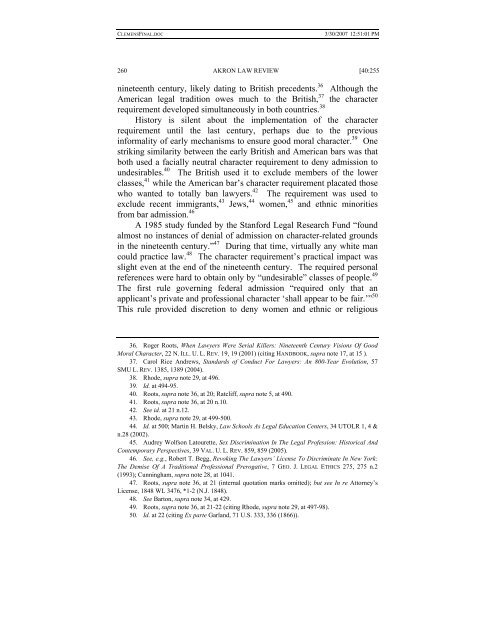Facing the Klieg Lights: Understanding the "Good Moral Character"
Facing the Klieg Lights: Understanding the "Good Moral Character"
Facing the Klieg Lights: Understanding the "Good Moral Character"
Create successful ePaper yourself
Turn your PDF publications into a flip-book with our unique Google optimized e-Paper software.
CLEMENSFINAL.DOC<br />
3/30/2007 12:51:01 PM<br />
260 AKRON LAW REVIEW [40:255<br />
nineteenth century, likely dating to British precedents. 36 Although <strong>the</strong><br />
American legal tradition owes much to <strong>the</strong> British, 37 <strong>the</strong> character<br />
requirement developed simultaneously in both countries. 38<br />
History is silent about <strong>the</strong> implementation of <strong>the</strong> character<br />
requirement until <strong>the</strong> last century, perhaps due to <strong>the</strong> previous<br />
informality of early mechanisms to ensure good moral character. 39 One<br />
striking similarity between <strong>the</strong> early British and American bars was that<br />
both used a facially neutral character requirement to deny admission to<br />
undesirables. 40 The British used it to exclude members of <strong>the</strong> lower<br />
classes, 41 while <strong>the</strong> American bar’s character requirement placated those<br />
who wanted to totally ban lawyers. 42 The requirement was used to<br />
exclude recent immigrants, 43 Jews, 44 women, 45 and ethnic minorities<br />
from bar admission. 46<br />
A 1985 study funded by <strong>the</strong> Stanford Legal Research Fund “found<br />
almost no instances of denial of admission on character-related grounds<br />
in <strong>the</strong> nineteenth century.” 47 During that time, virtually any white man<br />
could practice law. 48 The character requirement’s practical impact was<br />
slight even at <strong>the</strong> end of <strong>the</strong> nineteenth century. The required personal<br />
references were hard to obtain only by “undesirable” classes of people. 49<br />
The first rule governing federal admission “required only that an<br />
applicant’s private and professional character ‘shall appear to be fair.’” 50<br />
This rule provided discretion to deny women and ethnic or religious<br />
36. Roger Roots, When Lawyers Were Serial Killers: Nineteenth Century Visions Of <strong>Good</strong><br />
<strong>Moral</strong> Character, 22 N. ILL. U. L. REV. 19, 19 (2001) (citing HANDBOOK, supra note 17, at 15 ).<br />
37. Carol Rice Andrews, Standards of Conduct For Lawyers: An 800-Year Evolution, 57<br />
SMU L. REV. 1385, 1389 (2004).<br />
38. Rhode, supra note 29, at 496.<br />
39. Id. at 494-95.<br />
40. Roots, supra note 36, at 20; Ratcliff, supra note 5, at 490.<br />
41. Roots, supra note 36, at 20 n.10.<br />
42. See id. at 21 n.12.<br />
43. Rhode, supra note 29, at 499-500.<br />
44. Id. at 500; Martin H. Belsky, Law Schools As Legal Education Centers, 34 UTOLR 1, 4 &<br />
n.28 (2002).<br />
45. Audrey Wolfson Latourette, Sex Discrimination In The Legal Profession: Historical And<br />
Contemporary Perspectives, 39 VAL. U. L. REV. 859, 859 (2005).<br />
46. See, e.g., Robert T. Begg, Revoking The Lawyers’ License To Discriminate In New York:<br />
The Demise Of A Traditional Professional Prerogative, 7 GEO. J. LEGAL ETHICS 275, 275 n.2<br />
(1993); Cunningham, supra note 28, at 1041.<br />
47. Roots, supra note 36, at 21 (internal quotation marks omitted); but see In re Attorney’s<br />
License, 1848 WL 3476, *1-2 (N.J. 1848).<br />
48. See Barton, supra note 34, at 429.<br />
49. Roots, supra note 36, at 21-22 (citing Rhode, supra note 29, at 497-98).<br />
50. Id. at 22 (citing Ex parte Garland, 71 U.S. 333, 336 (1866)).
















